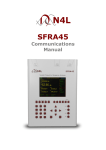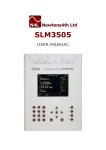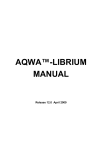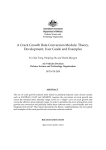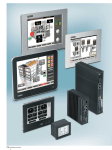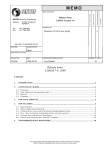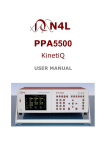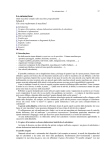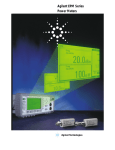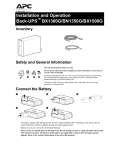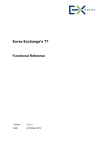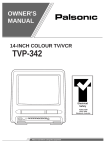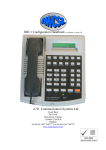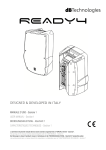Download SLM3505 Comms Manual v2_66
Transcript
SLM3505 COMMUNICATIONS MANUAL SLM3505 communications manual IMPORTANT SAFETY INSTRUCTIONS This equipment is designed to comply with BSEN 610101 (Safety requirements for electrical equipment for measurement, control, and laboratory use) – observe the following precautions: • Ensure that the supply voltage agrees with the rating of the instrument printed on the back panel before connecting the mains cord to the supply. • This appliance must be earthed. Ensure that the instrument is powered from a properly grounded supply. • The inputs must not be connected to signals greater than is indicated on the front panel. • Keep the ventilation holes on the underneath and sides free from obstruction. • Do not operate or store under conditions where condensation may occur or where conducting debris may enter the case. • There are no user serviceable parts inside the instrument – do not attempt to open the instrument, refer service to the manufacturer or his appointed agent. Note: Newtons4th Ltd. shall not be liable for any consequential damages, losses, costs or expenses arising from the use or misuse of this product however caused. i SLM3505 communications manual ABOUT THIS MANUAL This manual gives details of the communication commands recognized by the SLM3505 series of instruments over RS232, USB, or LAN. For more general operating instructions for the instrument refer to the user manual. Each command is listed alphabetically with details of any arguments and reply. A one line summary of each command is given in the appendix. Although most of the commands apply to all instruments in the range there are some commands that are specific to one instrument or another. The information in this manual is believed to be accurate and complete but Newtons4th Ltd cannot accept any liability whatsoever for any consequential damage or losses arising from any errors, inaccuracies, or omissions. Revision 2.66 This manual is copyright © 2008 - 2014 Newtons4th Ltd. and all rights are reserved. No part may be copied or reproduced in any form without prior written consent. 06th June 2014 ii SLM3505 communications manual CONTENTS 1 Using remote control ......................................... 1-1 1.1 1.2 1.3 Standard event status register .................................. 1-3 Serial Poll status byte .............................................. 1-4 RS232 connections .................................................. 1-5 2 Communication commands ................................. 2-1 *CLS ................................................................................ 2-1 *ESE ................................................................................ 2-2 *ESR?............................................................................... 2-3 *IDN? ............................................................................... 2-4 *OPC? .............................................................................. 2-5 *RST ................................................................................ 2-6 *SRE ................................................................................ 2-7 *STB? ............................................................................... 2-9 *TRG .............................................................................. 2-10 *TST? ............................................................................. 2-11 *WAI .............................................................................. 2-12 ABORT ............................................................................ 2-13 AMPLIT ........................................................................... 2-14 BEEP .............................................................................. 2-15 BLANKI ........................................................................... 2-16 CONFIG .......................................................................... 2-17 DAV? .............................................................................. 2-19 DAVER ............................................................................ 2-20 FILTER ............................................................................ 2-22 FRA ................................................................................ 2-23 FREQUE .......................................................................... 2-25 FSWEEP .......................................................................... 2-26 GAINPH .......................................................................... 2-27 HOLD ............................................................................. 2-29 INPUT ............................................................................. 2-30 KEYBOA .......................................................................... 2-31 LCR ................................................................................ 2-32 MARKER .......................................................................... 2-34 MODE ............................................................................. 2-35 OUTPUT .......................................................................... 2-36 PHCONV.......................................................................... 2-37 RANGE............................................................................ 2-39 RESOLU .......................................................................... 2-40 RESULT........................................................................... 2-41 iii SLM3505 communications manual RESULT? RESULT? ......... 2-42 REZERO .......................................................................... 2-43 SCALE ............................................................................ 2-44 SCREEN?......................................................................... 2-45 SLM ................................................................................ 2-46 SPEED ............................................................................ 2-48 START ............................................................................ 2-49 STATUS? ......................................................................... 2-50 STOP .............................................................................. 2-51 TFA ................................................................................ 2-52 USER? ............................................................................ 2-54 VERSIO? ......................................................................... 2-55 VSWR ............................................................................. 2-56 WAVEFO ......................................................................... 2-58 ZERO .............................................................................. 2-59 iv SLM3505 communications manual 1 Using remote control The instrument is fitted with an RS232 serial communications port and USB port as standard, and may have a LAN interface fitted as an option. All the interfaces use the same ASCII protocol with the following end of line terminators: RS232 USB LAN Rx expects carriage return (line feed ignored) Tx sends carriage return and line feed All the functions of the instrument can be programmed via any interface, and results read back. The port to be used is selected by the REMOTE menu. The commands are not case sensitive and white space characters are ignored (e.g. tabs and spaces). Replies from the instrument are always upper case, delimited by commas, without spaces. Only the first six characters of any command are important – any further characters will be ignored. For example, the command to set the generator frequency is FREQUE but the full word FREQUENCY may be sent as the redundant NCY at the end will be ignored. Fields within a command are delimited by comma, multiple commands can be sent on one line delimited with a semi-colon. Eg. AMPLIT,1.5;OUTPUT,ON Mandatory commands specified in the IEEE488.2 protocol have been implemented, (e.g. *IDN?, *RST) and all commands that expect a reply are terminated with a question mark. 1-1 SLM3505 communications manual The instrument maintains an error status byte consistent with the requirements of the IEEE488.2 protocol (called the standard event status register) that can be read by the mandatory command *ESR? (see section 5.1). The instrument also maintains a status byte consistent with the requirements of the IEEE488.2 protocol, that can be read by the mandatory command *STB? (see section 5.2). The keyboard is disabled when the instrument is set to “remote”. Press HOME to return to “local” operation. RS232 data format is: start bit, 8 data bits (no parity), 1 stop bit. Flow control is RTS/CTS (see section 5.2); baud rate is selectable via the REMOTE menu. A summary of the available commands is given in the Appendix. Details of each command are given in the communication command section of the manual. Commands are executed in sequence except for two special characters that are immediately obeyed: Control T (20) – reset interface (device clear) Control U (21) – warm restart 1-2 SLM3505 communications manual 1.1 PO N Standard event status register CM E EX E DD E QY E OP C bit 0 OPC (operation complete) cleared by most commands set when data available or sweep complete bit 2 QYE (unterminated query error) set if no message ready when data read bit 3 DDE (device dependent error) set when the instrument has an error bit 4 EXE (execution error) set when the command cannot be executed bit 5 CME (command interpretation error) set when a command has not been recognised bit 7 PON (power on event) set when power first applied or unit has reset The bits in the standard event status register except for OPC are set by the relevant event and cleared by specific command (*ESR?, *CLS, *RST). OPC is also cleared by most commands that change any part of the configuration of the instrument (such as MODE or START). 1-3 SLM3505 communications manual 1.2 Serial Poll status byte ES B MA V SD V RD V bit 0 RDV (result data available) set when results are available to be read as enabled by DAVER bit 1 SDV (sweep data available) set when sweep results are available to be read as enabled by DAVER bit 2 not used bit 3 not used) bit 4 MAV (message available) set when a message reply is waiting to be read bit 5 ESB (standard event summary bit) set if any bit in the standard event status register is set as well as the corresponding bit in the standard event status enable register (set by *ESE). 1-4 SLM3505 communications manual 1.3 RS232 connections The RS232 port on the instrument uses the same pinout as a standard 9 pin serial port on a PC or laptop (9-pin male ‘D’ type). Pin Functio n Direction 1 2 3 4 5 6 7 8 9 DCD RX data TX data DTR GND DSR RTS CTS RI in (+ weak pull up) in out out not used out in not used The instrument will only transmit when CTS (pin 8) is asserted, and can only receive if DCD (pin 1) is asserted. The instrument constantly asserts (+12V) DTR (pin 4) so this pin can be connected to any unwanted modem control inputs to force operation without handshaking. The instrument has a weak pull up on pin 1 as many null modem cables leave it open circuit. In electrically noisy environments, this pin should be driven or connected to pin 4. To connect the instrument to a PC, use a 9 pin female to 9 pin female null modem cable: 1&6 2 3 4 - 5 - 4 3 2 1& 6 5 1-5 SLM3505 communications manual 7 8 1-6 - 8 7 SLM3505 communications manual 2 Communication commands *CLS *CLS Function: Clear status Description: Clears the standard event status register. Format: *CLS Arguments: none Reply: none Example: *CLS *ESR? 0 Notes: 2-1 SLM3505 communications manual *ESE *ESE Function: Set standard register. event status enable Description: Enable which bits of the standard event status register set the ESB bit in the serial poll status byte.. Format: *ESE, value Arguments: decimal equivalent of bits in standard event status enable register Reply: can be read by *ESE? Example: *ESE, 60 Notes: The following bits in the standard event status enable register have been implemented: bit 0 OPC (operation complete) bit 2 QYE (unterminated query error) bit 3 DDE (device dependent error) bit 4 EXE (execution error) bit 5 CME (command interpretation error) bit 7 PON (power on event) For example, *ESE, 60 enables all the error bits so that the ESB bit in the serial poll status byte is set in the event of any error. 2-2 SLM3505 communications manual *ESR? *ESR? Function: Standard event status register query Description: Returns the contents of the standard event status register and clears it. Format: *ESR? Arguments: none Reply: decimal equivalent of bits in standard event status register Example: *ESR? 33 Notes: The following bits in the standard event status register have been implemented: bit 0 OPC (operation complete) bit 2 QYE (unterminated query error) bit 3 DDE (device dependent error) bit 4 EXE (execution error) bit 5 CME (command interpretation error) bit 7 PON (power on event) For example, if a command is sent incorrectly and is not recognised, the CME bit will be set and the value of 33 will be returned. 2-3 SLM3505 communications manual *IDN? *IDN? Function: Identify query Description: Returns a standard format identification string. Format: *IDN? Arguments: none Reply: An ASCII string in the IEEE488.2 format: manufacturer,model,serial no,version Example: *IDN? NEWTONS4TH,PSIMETRIQ,01234,1.00 Notes: 2-4 SLM3505 communications manual *OPC? *OPC? Function: Test for operation complete Description: Returns 1 if previous completed, 0 if not. Format: *OPC? Arguments: none Reply: 0 or 1 Example: START *OPC? 0 *OPC? 0 *OPC? 1 Notes: *OPC? can be used to indicate when data is available or when a frequency sweep has completed. operation 2-5 is SLM3505 communications manual *RST *RST Function: Reset Description: Resets the instrument to the default state and clears the standard event status register. Format: *RST Arguments: none Reply: none Example: *RST Notes: The *RST command loads the default configuration. This is the same as loading the default configuration via the PROGRAM menu. Any preceding setup commands will be overwritten. *RST should be followed by an end of line not a message separator. It may be helpful to follow it with a short pause to allow the new configuration to become active before sending further commands. 2-6 SLM3505 communications manual *SRE *SRE Function: Set service request enable register. Description: Enable which bits of the status byte register initiate a service request. Format: *SRE, value Arguments: decimal equivalent of bits in status byte register Reply: can be read by *SRE? Example: *SRE, 1 generate a service request when data available. Notes: 2-7 SLM3505 communications manual *SRE? *SRE? Function: Read service request enable register. Description: Read back the present setting of the service request enable register. Format: *SRE? Arguments: Reply: decimal equivalent of bits in status byte register that would generate a service request. Example: *SRE? 1 Notes: 2-8 SLM3505 communications manual *STB? *STB? Function: Read serial poll status byte Description: Returns the decimal value of the serial poll status byte. Format: *STB? Arguments: none Reply: decimal value of the serial poll status byte Example: *STB? 1 Notes: The following bits in the serial poll status register have been implemented: bit 0 bit 1 bit 3 bit 4 bit 5 bit) RDV SDV ALA MAV ESB (results data available) (sweep data available) (alarm active) (message available) (standard event summary 2-9 SLM3505 communications manual *TRG *TRG Function: Trigger Description: Initiates a new measurement, resets the ranging and filtering. Format: *TRG Arguments: none Reply: none Example: MODE,VRMS *TRG VRMS? Notes: 2-10 SLM3505 communications manual *TST? *TST? Function: Self test query Description: Returns the results of self test Format: *TST? Arguments: none Reply: single integer bit 0 – set if uncalibrated bit 1 – set if error with analogue zero > 15 – major system error Example: *TST? 0 Notes: 2-11 SLM3505 communications manual *WAI *WAI Function: Wait for operation complete Description: Suspends communication until the previous operation has completed Format: *WAI Arguments: none Reply: none Example: GAINPH START *WAI GAINPH,SWEEP? Notes: In the example, the query command GAINPH,SWEEP? can be sent immediately after the *WAI command and the sweep data will be returned as soon as the sweep has completed. 2-12 SLM3505 communications manual ABORT ABORT Function: Abort sweep Description: Abort an active sweep. Format: ABORT Arguments: none Reply: none Example: FSWEEP,1000,1E5,5E5 START ABORT Notes: 2-13 SLM3505 communications manual AMPLIT AMPLIT Function: Set output amplitude Description: Sets the output amplitude in Volts or dBm for the generator. Format: AMPLIT,amplitude Arguments: peak amplitude in Volts or amplitude in dBm Reply: none Example: AMPLIT,0.5 0.5V) Notes: The amplitude may be Volts or dBm for either the low level or hi level output. 2-14 (set peak amplitude to SLM3505 communications manual BEEP BEEP Function: Sound the buzzer Description: Makes a “beep” from the instrument. Format: BEEP Arguments: none Reply: none Example: BEEP Notes: 2-15 SLM3505 communications manual BLANKI BLANKI Function: Select blanking Description: Enable or disable low value blanking. Format: BLANKI,value,threshold Arguments: value: ON OFF threshold: threshold in appropriate units Reply: none Example: BLANKI,OFF BLANKI,ON,-35 Notes: 2-16 SLM3505 communications manual CONFIG CONFIG Function: Direct access of configuration parameters Description: Sets configuration parameter for which there may not be a direct command. Format: CONFIG,index,data Arguments: index is the number of the parameter data is the data for that parameter Reply: none Example: CONFIG,6,1 Notes: The list of configurable parameters is given in the appendix. CONFIG goes through the same limit checking as when entering data from the menus. (set phase convention) 2-17 SLM3505 communications manual CONFIG? CONFIG? Function: Configurable parameter query Description: Reads the present value of a single parameter. Format: or: CONFIG,index? CONFIG?index Arguments: index is the parameter number Reply: Value of parameter, real or integer as appropriate. Example: CONFIG,6? 0 CONFIG,6,1 CONFIG,6? 1 Notes: The list of configurable parameters is given in the appendix. 2-18 (read phase convention) SLM3505 communications manual DAV? DAV? Function: Data available query Description: Returns data availability status. Format: DAV? Arguments: none Reply: Decimal equivalent of data available bits: bit0 new data available bit1 data available bit2 new full sweep data available bit3 sweep data available bit4 streaming data available bit5 more streaming data to come bit6 integration data available bit7 datalog data available Example: START DAV? 0 DAV? 11 DAV? 11 DAV? 11 DAV? 15 Notes: (trigger sweep) (first data available) (full sweep data available) DAV? does not modify the status bits. 2-19 SLM3505 communications manual DAVER DAVER Function: Set data available enable register Description: Sets bits in the data available enable register to control which status bits set the data available bits in the status byte. Format: DAVER,value Arguments: decimal equivalent of data available bits bit0 set bit 0 of status byte when new data available bit1 set bit 0 of status byte when data available bit2 set bit 1 of status byte when new full sweep data available bit3 set bit 1 of status byte when sweep data available bit4 set bit 2 of status byte when streaming data available bit5 set bit 2 of status byte if more streaming data is to come Reply: none Example: DAVER, 4 set bit 1 in status byte only when full sweep data is ready Notes: default value is 6: bit 0 of status byte is set whenever data is available bit 1 of status byte is set when full sweep data is available. 2-20 SLM3505 communications manual DAVER? DAVER? Function: Read data available enable register Description: Read back present setting of the data available enable register, which controls the status bits that set the data available bits in the status byte. Format: DAVER? Arguments: none Reply: decimal equivalent of bits Example: DAVER? 4 Notes: 2-21 SLM3505 communications manual FILTER FILTER Function: Select the filtering Description: Sets the filter time dynamic response. Format: FILTER,type,dynamics Arguments: type: NONE NORMAL SLOW dynamics: AUTO FIXED Reply: none Example: FILTER,NORMAL,FIXED FILTER,NONE Notes: It is not necessary to send both parameters if it is only required to set the type. Both arguments must be sent to set the dynamics. 2-22 constant and SLM3505 communications manual FRA FRA Function: Set frequency response analyser mode. Description: Set frequency response analyser mode. Format: FRA Arguments: Reply: none Example: FRA Notes: This command has the same effect as MODE,GAINPH. FRA, GAINPH, TFA are aliases for the same command. 2-23 SLM3505 communications manual FRA? FRA? Function: frequency response analyser query Description: Read frequency response analyser results. Sets frequency response analyser mode if not already set. Waits for next unread data if necessary. Clears new data available bit read by DAV? Format: or: or: FRA? FRA?SWEEP FRA,SWEEP? Arguments: none, or SWEEP Reply: 6 data values separated by commas freq, mag1,mag2,db,phase,gain one line per result for sweep data Example: OUTPUT,ON FRA FSWEEP,20,10,20E3 START DAV? 3 DAV? 15 FRA?SWEEP data returned Notes: FRA? waits for next unread data. FRA?SWEEP does not wait for new data – data can be read multiple times. FRA, GAINPH, TFA are aliases for the same command 2-24 SLM3505 communications manual FREQUE FREQUE Function: Set the output frequency Description: Sets the generator output frequency in Hz. Format: FREQUE,frequency Arguments: frequency in Hz Reply: none Example: FREQUE,5e4 50kHz) (set frequency to Notes: 2-25 SLM3505 communications manual FSWEEP FSWEEP Function: Set the frequency sweep parameters Description: Sets the start frequency in Hz, the end frequency, the number of steps and log/linear for the selected function. Format: FSWEEP,steps,start,end,type Arguments: steps: number of steps start: start frequency in Hz end: end frequency in Hz type: LOGARI LINEAR Reply: none Example: MODE,GAINPH FSWEEP,50,1000,1e6 (set 50 steps between 1kHz and 1MHz) Notes: It is not necessary to send all the arguments, but if they must be in the specified order. The same command is used for all the functions – the data is applied to whichever function has been selected if valid (such as gain/phase analyser). If the selected mode is not valid (such as rms), then the command is ignored and an execution error is flagged in the standard event status register, sesr. 2-26 SLM3505 communications manual GAINPH GAINPH Function: Set gain/phase analyser mode. Description: Set gain/phase analyser mode. Format: GAINPH Arguments: Reply: none Example: GAINPH Notes: This command has the same effect as MODE,GAINPH. FRA, GAINPH, TFA are aliases for the same command. 2-27 SLM3505 communications manual GAINPH? GAINPH? Function: Gain/phase query Description: Read gain/phase analyser results. Sets gain/phase analyser mode if not already set. Waits for next unread data if necessary . Clears new data available bit read by DAV? Format: or: or: GAINPH? GAINPH?SWEEP GAINPH,SWEEP? Arguments: none, or SWEEP Reply: 6 data values separated by commas freq, mag1,mag2,db,phase,gain one line per result for sweep data Example: OUTPUT,ON GAINPH FSWEEP,20,10,20E3 START DAV? 3 DAV? 15 GAINPH?SWEEP data returned Notes: GAINPH? waits for next unread data. GAINPH?SWEEP does not wait for new data – data can be read multiple times. 2-28 SLM3505 communications manual HOLD HOLD Function: Set/clear HOLD mode Description: HOLD mode stops the instrument from updating the measured values Format: HOLD,value Arguments: value: ON OFF Reply: none Example: HOLD,ON Notes: 2-29 SLM3505 communications manual INPUT INPUT Function: Set input mode Description: Selects the input type of the instrument Format: INPUT,type,impedance Arguments: type: HILEVEL POWER LOLEVEL BALANCE impedance: 50OHMS 75OHMS 600OHMS HIIMPEDANCE Reply: none Example: INPUT,LOLEVE,HIIMPE Notes: The impedance value is only valid for the low level input 2-30 SLM3505 communications manual KEYBOA KEYBOA Function: Disable front panel keyboard. Description: The front panel keyboard can be disabled to prevent accidental operation. Format: KEYBOARD,value Arguments: value: ENABLE DISABLE Reply: none Example: KEYBOARD,DISABLE Notes: The keyboard can be re-enabled from the front panel only by pressing the HOME key. 2-31 SLM3505 communications manual LCR LCR Function: Set LCR meter mode. Description: Set LCR mode and model. Format: LCR,model Arguments: model: IMPEDANCE SERIES PARALLEL Reply: none Example: LCR, IMPEDA Notes: 2-32 SLM3505 communications manual LCR? LCR? Function: LCR meter query Description: Read LCR meter results. Sets LCR meter mode if not already set. Waits for next unread data if necessary. Clears new data available bit read by DAV? Format: or: or: LCR? LCR?SWEEP LCR,SWEEP? Arguments: none, or SWEEP Reply: 14 data values separated by commas: freq, mag1, mag2, impedance, phase, series R, series L, series C, Parallel R, Parallel L, Parallel C, tanδ, Q, reactance. sweep reply: 8 data values per line per sweep result: freq,Q,tanδ,impedance,phase,L,C,R Example: OUTPUT,LOLEVE LCR? data returned Notes: LCR? waits for next unread data. LCR?SWEEP does not wait for new data – data can be read multiple times. 2-33 SLM3505 communications manual MARKER MARKER Function: Set frequency marker Description: Enable or disable frequency marker. Format: MARKER,value,frequency Arguments: value: Off Single Dual frequency: marker frequency in Hz Reply: none Example: MARKER,OFF MARKER,Single,25e3 Notes: It is not necessary to send the frequency when enabling the marker if it has already been set. 2-34 SLM3505 communications manual MODE MODE Function: Set mode Description: Sets the fundamental operating mode of the instrument. Format: MODE,type Arguments: type: SLM LCR VSWR FRA SCOPE Reply: none Example: MODE,SLM Notes: MODE sets the measurement mode of the instrument 2-35 SLM3505 communications manual OUTPUT OUTPUT Function: Set output Description: Turns the output on or off, or sets the level mode to dBm or voltage. Also specifies action at the end of a sweep Format: OUTPUT,type,impedance Arguments: command: OFF LOLEVEL HILEVEL impedance: 50OHMS 75OHMS 600OHMS HIIMPEDANCE Reply: none Example: OUTPUT,LOLEVE,600OHM Notes: For safety, the output defaults to off and must be turned on explicitly. 2-36 SLM3505 communications manual PHCONV PHCONV Function: Set phase convention Description: Set phase convention Format: PHCONV,convention Arguments: convention: 180: -180 to +180 -360: 0 to -360 +360: 0 to +360 Reply: none Example: PHCONV, -360 Notes: Notes: Number 0 represents factory default, which can only be recalled. 2-37 SLM3505 communications manual PROGRA? PROGRA? Function: Identify current program. Description: Reads the name of the last program to be loaded or recalled. Format: PROGRA? Arguments: none Reply: text string Example: PROGRA? factory default Notes: 2-38 SLM3505 communications manual RANGE RANGE Function: Set channel ranging. Description: Select minimum range and range control for a given input channel. Format: RANGE,channel,ranging,range Arguments: channel: CH1 CH2 ranging: AUTO UPAUTO MANUAL range: nominal range value Reply: none Example: RANGE,CH2,MANUAL,3V Notes: 2-39 SLM3505 communications manual RESOLU RESOLU Function: Set the data resolution Description: Data is returned in scientific format with exponent and mantissa. The resolution of the mantissa may be selected to be 5 digit (NORMAL) or 6 digit (HIGH). Format: RESOLU,format Arguments: format: NORMAL HIGH BINARY Reply: none Example: RESOLU,HIGH Notes: The resolution only changes the real number replies. Data format for NORMAL is: [-]1.2345E[-]00 Data format for HIGH is: [-]1.23456E[-]00 The signs of the mantissa and exponent, shown as [-] in the above examples, are only sent if they are negative. Data format for BINARY is a proprietary floating point format which returns raw data in a minimum number of data bytes. 2-40 (5 digit mantissa) (6 digit mantissa) (raw binary format) SLM3505 communications manual RESULT RESULT Function: Access non volatile results stores. Description: Recall, store results store. Format: RESULT,function,number Arguments: function: RECALL STORE DELETE number 1-999 Reply: none Example: RESULT,RECALL,13 or delete non-volatile Notes: 2-41 SLM3505 communications manual RESULT? RESULT? Function: Access non volatile results stores. Description: Recall, store results store. Format: RESULT,function? Arguments: function: NAME FILES N4LFIL TXTFIL Reply: NAME - name of current program FILES - list of names of stored files N4LFIL– results in .N4L format TXTFIL– results in .TXT format Example: RESULT,N4LFIL? Notes: 2-42 or delete non-volatile SLM3505 communications manual REZERO REZERO Function: Rezero front end Description: Request the DSP to re-compensate for dc offset and compute a new autozero Format: REZERO Arguments: none Reply: none Example: REZERO Notes: 2-43 SLM3505 communications manual SCALE SCALE Function: Set channel scale factor. Description: Set a multiplying scale factor for a given input channel. Format: SCALE,channel,factor Arguments: channel: CH1 CH2 factor: multiplying scale factor Reply: none Example: SCALE,CH2,10 Notes: 2-44 SLM3505 communications manual SCREEN? SCREEN? Function: Read the screen data Description: Returns a bit map of screen pixel display in ascii and hex format Format: SCREEN? Arguments: none Reply: Multiple data bit values Example: SCREEN? data returned Notes: SCREEN? response: ASCII coded Hex (2 characters for each byte) 240 lines of 40 bytes (each line represents one line of the display) preceded by #H Each byte represents 8 dots where the lsb is the leftmost dot of the display The bit is set for on and cleared for off 2-45 SLM3505 communications manual SLM SLM Function: Set up selective level meter. Description: Set mode to selective level meter, and set up centre frequency. Format: SLM,bandwidth,scan,freq1,freq2 Arguments: bandwidth: WIDE 3100HZ 1950HZ 100HZ 360Hz 400Hz 25HZ 3HZ scan: GENERATOR AFC FIXED DUAL INPUT frequency1: centre frequency in Hz frequency2: dual frequency in Hz Reply: none Examples: SLM,100HZ,SINGLE,1.50e5 Notes: It is not necessary to send all the arguments, but if they must be in the specified order. 2-46 SLM3505 communications manual SLM? SLM? Function: Read selective level meter results Description: Reads back latest selective level meter results. Sets voltmeter mode if not already set. Waits for next unread data if necessary. Clears new data available bit read by DAV? Format: or: SLM? SLM,SWEEP? Arguments: none Reply: single: 3 data values separated by commas freq,mag,dbm dual: 6 data values separated by commas freq1,mag1,dbm1,freq2,mag2,dbm2 sweep: one result as above per line Example: SLM,100HZ,FIXED,150e3 SLM? 1.5000E5,7.3508E-2,-9.6630E+0 SLM? 1.5000E5,7.3511E-2,-9.6627E+0 Notes: As SLM? does not send the same data twice but waits instead for the next result, it is not necessary to check the data available bits before sending the SLM? command. 2-47 SLM3505 communications manual SPEED SPEED Function: Sets the measurement speed Description: Sets the minimum window size for the measurement (FRA and LCR modes). Format: SPEED,value SPEED,WINDOW,time Arguments: value: FAST MEDIUM SLOW VSLOW VFAST time: window time in seconds Reply: none Example: SPEED,SLOW Notes: 2-48 SLM3505 communications manual START START Function: Start sweep Description: Initiate sweep in those functions that have a sweep or resets filtering in others. Format: START Arguments: none Reply: none Example: FSWEEP,100,50000,75000 START Notes: 2-49 SLM3505 communications manual STATUS? STATUS? Function: Read back channel ranging status. Description: Read back condition of selected channel: range number (1-16) range text overflow/underflow status Format: or: STATUS,channel? STATUS?channel Arguments: channel: CH1 CH2 Reply: range number,range text,over/under/ok 1-16 range as per RANGE command OVER if overflow LOW if underflow OK if in range Example: STATUS,CH1? 6,3V,OK Notes: 2-50 SLM3505 communications manual STOP STOP Function: Stop sweep Description: Stop an active sweep. Format: STOP Arguments: none Reply: none Example: FSWEEP,100,50000,75000 START STOP Notes: 2-51 SLM3505 communications manual TFA TFA Function: Set transfer function analyser mode. Description: Set transfer function analyser mode. Format: TFA Arguments: Reply: none Example: TFA Notes: This command has the same effect as MODE,GAINPH. FRA, GAINPH, TFA are aliases for the same command. 2-52 SLM3505 communications manual TFA? TFA? Function: transfer function analyser query Description: Read transfer function analyser results. Sets transfer function analyser mode if not already set. Waits for next unread data if necessary. Clears new data available bit read by DAV? Format: or: or: TFA? TFA?SWEEP TFA,SWEEP? Arguments: none, or SWEEP Reply: 6 data values separated by commas freq, mag1,mag2,db,phase,gain one line per result for sweep data Example: OUTPUT,ON TFA FSWEEP,20,10,20E3 START DAV? 3 DAV? 15 TFA?SWEEP data returned Notes: TFA? waits for next unread data. TFA?SWEEP does not wait for new data – data can be read multiple times. FRA, GAINPH, TFA are aliases for the same command 2-53 SLM3505 communications manual USER? USER? Function: Read the user data Description: Returns up to 3 lines of user data Format: USER? Arguments: none Reply: 3 lines of ASCII terminated by CR Example: USER? Newtons4th Ltd R&D department SLM3505 #4 Notes: 2-54 SLM3505 communications manual VERSIO? VERSIO? Function: Read the instrument code versions. Description: Returns an ASCII string with the details of the various parts of the instrument firmware. Format: VERSIO? Arguments: none Reply: date code, type, cpu, dsp, fpga, boot Examples: VERSION? PQ3504,1,2.01,2.20,2.20,2.02 Notes: This data can be displayed on the screen by pressing SYSTEM then BACK 2-55 SLM3505 communications manual VSWR VSWR Function: Set up VSWR meter. Description: Set mode to VSWR level meter with specified method. Format: VSWR,method,scale Arguments: method: impedance directional scale: scale factor for directional coupler Reply: none Examples: VSWR,IMPEDA Notes: 2-56 SLM3505 communications manual VSWR? VSRW? Function: Read VSWR meter results Description: Reads back latest VSWR meter results. Sets VSWR mode if not already set. Waits for next unread data if necessary. Clears new data available bit read by DAV? Format: or: VSWR? VSWR,SWEEP? Arguments: none Reply: 6 data values separated by commas frequency, forward power, VSWR, reflection %, reflection dB, reflected power Example: VSWR,IMPEDA VSWR? 6 data values returned Notes: As VSWR? does not send the same data twice but waits instead for the next result, it is not necessary to check the data available bits before sending the VSWR? command. 2-57 SLM3505 communications manual WAVEFO WAVEFO Function: Set the output waveform Description: Selects the output waveform for the signal generator. Format: WAVEFO,type Arguments: type: SINEWA TRIANG SQUARE NOISE Reply: None Example: FREQUE,500 WAVEFO,TRIANG OUTPUT,ON Notes: 2-58 (sine wave) (triangle wave) (square wave) (white noise) (triangle wave) SLM3505 communications manual ZERO ZERO Function: Apply or remove the zero Description: Applies or removes a zero function depending on the measurement mode (same as pressing ZERO key). Performs lead compensation in LCR mode. Format: ZERO ZERO,DELETE ZERO,DB,offset ZERO,PHASE,offset LCR compensatio n ZERO,SINGLE ZERO,SWEEP,steps,start,finish ZERO,OPEN ZERO,SHORT ZERO,STORE ZERO,RECALL Arguments: offset: offset value steps: LCR sweep compensation steps start: LCR compensation start frequency stop: LCR compensation stop frequency Reply: none Example: ZERO,SWEEP,100,1e3,1e6 ZERO,OPEN performs open circuit compensation Notes: 2-59 SLM3505 communications manual Appendices COMMAND SUMMARY CONFIGURABLE PARAMETERS A-1 SLM3505 communications manual command format *CLS *ESE,value *ESE? *ESR? *IDN? *OPC? *RST *SRE,value *SRE? *STB? *TRG *TST? *WAI ABORT AMPLIT,amplitude BEEP BLANKI,on/off,threshold CONFIG,parameter,data CONFIG,parameter? DAV? DAVER,value DAVER? FILTER,type,dynamics FRA FRA? FRA,SWEEP? FREQUE,frequency FSWEEP,steps,start,end,l og GAINPH GAINPH? GAINPH,SWEEP? HOLD,on/off INPUT,type,impedance KEYBOA,value LCR,conditions,param,he ad LCR? A-2 reply format single integer data value single integer data value company,product,serial no,version 0 or 1 single integer data value single integer data value single integer data value single integer or real data value single integer data value single integer data value freq,gain,phase,dB,mag1,mag2 n lines of FRA? data freq,mag1,mag2,db,phase,gain n lines of GAINPH? data freq, mag1, mag2, impedance, phase, R, L, C (series), R, L, C (parallel), tanδ, Q, reactance SLM3505 communications manual LCR,SWEEP? MARKER,on/off,frequency MODE,type OUTPUT,type,impedance PHCONV,convention PROGRAM,function,numb er PROGRAM? RANGE,ch,ranging,range RESOLU.format RESULT,function,number REZERO SCALE,channel,factor SCALE,channel? SHUNT,channel,resistanc e SHUNT,channel? SPEED,speed START STATUS,channel? STOP TFA TFA? TFA,SWEEP? USER? VERSION? VRMS VRMS? VSWR,method VSWR? VSWR,SWEEP? WAVEFO,type ZERO ZERO,DELETE n lines of data: freq,Q,tanδ,impedance, phase,L,C,R CR terminated text string single real data value single real data value range number,range text,over/low/ok freq,gain,phase,dB,mag1,mag2 n lines of TFA? data 3 CR terminated text strings datecode,type,cpu,dsp,fpga,boot rms,dbm freq,fdbm,vswr,r%,rdb,rdbm n lines of VSWR? data A-3 SLM3505 communications manual calibration commands CALAPP CALCOM,freq CALDCO,value CALFIL,index,value CALFIL? CALFRQ,index,freq CALFRQ? CALHF,index,value CALIBR,index,value CALIBR? CALIDS,string CALIDS? CALOUT,index,value CALPHA,index CALRES CALSAV,password CALSNO,serial number CALSTR,string CALSTR? A-4 six real data values seven real data values single integer data value string string SLM3505 communications manual Appendix B – Configurable parameters All parameters can be accessed using the CONFIG command: CONFIG,parameter,data Numb er Function 1 System parameters Operating mode, (Sets main mode) 2 Interface, 3 Bandwidth auto or wide, (SLM Measurements) 6 Phase convention, 7 0=Selective Level Meter 1=Impedance Meter 2=Oscilloscope 3=VSWR Meter 4=Frequency Response Analyser (Remote settings) 0=RS232 1=USB 2=LAN 0=Wide 1=3.1KHz 2=1.95KHz 3=600Hz 4=400 5=360Hz 6=100Hz 7=25Hz 8=3Hz 9=1Hz (System Options) 0=-180° to +180° 1=0° to -360° 2=0° to +360° Output , (Generator settings) 0=Off 1=Low Output 2=High Output B-1 SLM3505 communications manual 8 Step message, 9 Keyboard beep on/off, 11 Output impedance, 13 Speed, 14 Filter, 16 Baud rate, 18 Sweep steps, 19 Sweep start frequency, 20 Sweep stop frequency, 21 Sweep type, 22 Resolution, B-2 (System Options) 0=Disabled 1=Enabled (System Options) 0=Enabled 1=Disabled (Generator Settings) 0=50Ω 1=75Ω 2=600Ω (FRA/LCR Measurement Settings) 0=Very Slow 1=Slow 2=Medium 3=Fast 4=Very Fast (FRA/LCR Measurement Settings) 0=Normal 1=Slow 2=None (Remote Settings “RS232”) 0=38400 1=19200 2=9600 3=1200 (Sweep Settings Enter step number figures) (Sweep Settings-Enter figures) (Sweep Settings-Enter figures) (Sweep Settings) 0=Single 1=Continuous (Remote Settings) SLM3505 communications manual 0=Normal 1=High 24 Input, 28 CH1 input ranging, (Input Settings) 29 CH2 input ranging, (Input Settings FRA Only) 32 CH1 scale factor, 36 Impedance, (Input Settings) 39 Brightness, (System Options) 40 Display, 42 Enlarge results, 47 Display type, (Input Settings) 0=High Z 1=50Ω 18W 2=Low level 3=Balanced 0=Full Autorange 1=Range Up Only 2=Manual 0=Full Autorange 1=Range Up Only 2=Manual (Input Settings-Enter figures) 0=50Ω 1=75Ω 2=600Ω 3=High Impedance 0=Low 1=High (System Options) 0=Colour 1=White on black 2=Black on white (System Options) 0=Off 1=On (Sweep Settings) 0=Real time 1=Table B-3 SLM3505 communications manual 2=Graph 48 Generator frequency, 49 Low output amplitude V, 50 FSK Control, 51 Generator waveform, 52 Frequency step, (Generator Settings-Enter figures) 53 Amplitude Step, (Generator Settings-Enter figures) 54 Low output amplitude dBm, 55 Amplitude step, 56 Amplitude control, 57 Guard time, 58 FSK Frequency “0”, 59 FSK Fequency “1”, 60 Sweep type, 61 Graph scaling, B-4 (Generator Settings-Enter figures) figures) (Generator Settings-Low output-Enter (Generator Settings) 0=Disabled 1=Enabled (Generator Settings) 0=Sinewave 1=Triangle 2=Squarewave 3=White Noise (Generator Settings-Enter dBm figures) (Generator Settings-Enter dB figures) (Generator Settings) 0=Volts 1=dBm 2=dBu (Generator Settings-FSK control-Enter figures) (Generator Settings-FSK control-Enter figures) (Generator Settings-FSK control-Enter figures) (Sweep Settings +Step Type -SLM/VSWR/Output & Tune) 0=Logarithmic 1=Linear (Sweep Settings) 0=Auto 1=Manual SLM3505 communications manual 62 Graph max, 63 64 Graph min, (Sweep settings-Enter figures) Frequency marker, (Sweep Settings) 65 Marker frequency 1, 66 Search for peak, 67 AutoTune type, 68 Marker frequency 2, 70 High output amplitude V, 71 High output amplitude dBm, 75 Graph, 76 Computation, 78 Centre frequency, 80 81 (Sweep settings-Enter figures) 0=Off 1=Single 1=Dual (Sweep Settings-Marker on-Enter figures) (Sweep Settings, SLM Mode) 0=Off 1=On (Tune Settings) 0=3 stage autotune 1=Single stage retune (Sweep Settings-Marker on-Enter figures) (Generator Settings-Output high-Enter figures) (Generator Settings-Enter dBm figures) (FRA Settings) 0=Phase 1=Gain (FRA Settings) 0=CH2/CH1 1=CH1/CH2 (SLM Settings) 0=Generator frequency 1=AFC 2=Single fixed 3=Dual fixed 4=Input frequency Centre frequency 1, (SLM/VSWR/Tune Settings-Center Freq-Dual-Enter Centre frequency 2, (SLM Settings-Center Freq-Dual-Enter figures) figures) B-5 SLM3505 communications manual 82 Threshold, 83 Frequency step, 84 Peak level, 85 Frequency step, 87 AFC Gain, 88 Timebase, 89 Trigger level, 90 Pretrigger, 91 Trigger polarity, 92 Trigger mode, 94 Traces, 95 Trigger channel, 100 Method, B-6 (SLM Settings-Enter figures) ( For Logarithmic Frequency step setting-Enter figures) (SLM Settings) 0=Off 1=On (For Linear Frequency step setting-Enter figures) (SLM measurement settings-centre frequency-AFC-Enter figures) (Oscilloscope Settings-Enter figures) (Oscilloscope Settings-Enter figures) (Oscilloscope Settings) 0=None 1=25% 2=50% 3=75% (Oscilloscope Settings) 0=Rising edge 1=Falling edge (Oscilloscope Settings) 0=Auto 1=Normal 2=Single shot (Oscilloscope Settings) 0=Single 1=Dual 2=CH2 Current (Oscilloscope Settings) 0=CH1 1=CH2 (VSWR Settings) 0=Impedance 1=Directional coupler SLM3505 communications manual 101 Scale Factor, 102 Bandwidth, 104 Measurement, 110 Search for peak, 112 Initial settings, 113 Peak hold, 114 Reference impedance, (VSWR Settings-Directional coupler-Enter figures) (VSWR Settings-Directional coupler) 0=3.1KHz 1=1.95KHz 2=100Hz 3=360Hz 4=400Hz 5=25Hz 6=3Hz 7=1Hz (LCR Settings) 0=Impedance magnitude 1=Parallel circuit 2=series circuit (Sweep Settings, LCR Mode) 0=Off 1=Single 2=Dual (System settings) 0=Program 1 1=Factory default 2=As last used (Sweep Settings) 0=Off 1=On (VSWR Settings) 0=50Ω 1=75 Ω 2=120Ω 3=135Ω 4=150Ω 5=600Ω B-7 SLM3505 communications manual 117 IP Address, 121 Language, 128 Bargraph, 129 Bargraph max, 130 Bargraph min, 132 Set Clock, (System settings-Hours) 133 Set Clock, (System settings-Mins) 134 Set Clock, (System settings-Secs) 135 Set Date, (System settings-Day) 136 Set Date, (System settings-Month) 137 Set Date, (System settings-Year) B-8 (Remote settings-LAN-Entre address numbers) (System Settings) 0=English 1=Italian (SLM Settings) 0=Off 1=On (SLM settings-Bargraph-Enter numbers) (SLM settings-Bargraph-Enter numbers) Newtons4th Ltd. contact details Please direct all queries or comments regarding the SLM3505 instruments or this manual to: Newtons4th Ltd. 1 Bede Island Road Leicester LE2 7EA United Kingdom Tel: (0116) 230 1066 International +44 116 230 1066 Fax: (0116) 230 1061 International +44 116 230 1061 E-mail address: [email protected] [email protected] Web site: www.newtons4th.com At Newtons4th Ltd. we have a policy of continuous product improvement and are always keen to hear comments, whether favourable or unfavourable, from users of our products. Please telephone, fax, write or email with your comments.




















































































